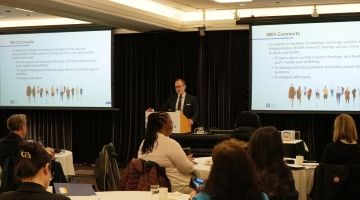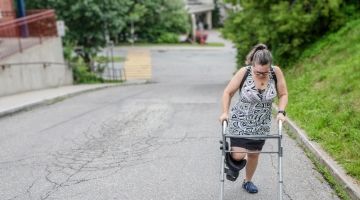Plain-language summaries
Institute for Work & Health (IWH) plain-language summaries condense research findings in various formats. At Work articles explain study results with comments from the study leads. Research Highlights summarize journal articles in easy-to-read, digest formats. Sharing Best Evidence summaries highlight findings from systematic reviews and other types of reviews conducted or led by IWH researchers. Issue Briefings discuss key research findings from IWH or elsewhere on topics that are of particular interest to policy-makers.

At Work article
Do women and men have different risks of getting an infectious disease from work?
Within a given occupation, men and women often face different risks of experiencing a work-related injury. But are those trends the same when it comes to the risks of work-related infectious diseases? According to an IWH systematic review of studies published between 2016 and 2021, women and men in the same jobs have similar risks of getting an infectious disease from work—with a few exceptions.
Published:

Research Highlights
Death rates are higher for workers in precarious and lower quality jobs
Death rates are higher for workers in lower-quality jobs. That’s according to an IWH study that explored whether job quality was linked to rates of death. It analyzed workers’ risk of dying over a 13-year period—comparing not just workers in standard and precarious jobs but those in other types of job quality in between.
Published:

At Work article
Inclusive employment strategies, resources showcased at symposium
Tompa E
At a two-day event symposium hosted by Inclusive Design for Employment Access (IDEA), stakeholders had an opportunity to share and learn about new programs, research, and resources aimed at helping employers build their disability confidence.
Published:

Research Highlights
Mental health of Canadians who work from home no better or worse than those working outside the home
Canadian adults who work from home report the same levels of mental health, life satisfaction and stress as those who work on-site at a workplace, or at no fixed location (on the road). That’s according to a study of survey data from almost 25,000 Canadians in 2022, after work-from-home arrangements became more common.
Published:

At Work article
Differences in firm-level AI use for health and safety
To what extent are Canadian workplaces using artificial intelligence (AI) to help support workers’ health and safety? And what do these workplaces have in common? An IWH study found that about a quarter of firms surveyed across Ontario and British Columbia were using AI for occupational health and safety (OHS). Those that were more likely to use the technology for OHS were larger organizations and those where workers were more frequently exposed to hazards.
Published:

At Work article
Parental job quality linked to children’s mental health, school performance
Children whose parents work low-quality, precarious jobs are more likely to experience mental health problems and perform poorly at school. That’s according to a pair of studies, co-led by the Institute for Work & Health (IWH), that drew on two large-scale surveys of children and parents from Ontario and across Canada.
Published:

At Work article
IWH knowledge transfer and exchange approach a ‘perfect fit’ for episodic disabilities project
Researchers and knowledge transfer and exchange (KTE) staff at the Institute for Work & Health (IWH) put a lot of focus on how to tap into partner expertise to refine research goals and facilitate the sharing and uptake of research findings. What does that look like in practice? This article illustrates how a seven-year partnership project used IWH’s approach to KTE to develop and share usable outputs from the research findings.
Published:

At Work article
Preventing PTSI work disability at first responder organizations: perspectives from the workplace
Across Canada, police, fire and paramedic services are aware of the toll of post-traumatic stress injuries (PTSI) on their workforce. In a multi-part study, an IWH team drew on interviews with leaders and members in first response services to learn what they’re currently doing to prevent PTSI work disability—and what barriers and facilitators they’ve experienced—to distill several recommendations.
Published:

At Work article
Arts-based study reveals complexities of working as a nail technician
Workplace hazards have been the focus of many studies on the health and safety of nail salons and their workers. But an arts-based study strived to demonstrate the complexity of nail technicians’ relationships to their work, finding both harms and joys.
Published:

Research Highlights
Which workers and jobs will be most affected by machine learning?
Machine learning is being adopted by more and more Canadian workplaces. Given this technology’s ability to learn, adapt and generate work outputs, it also has the potential to perform job tasks in place of humans. But which workers might be most affected by the use of machine learning? An IWH study explores this question.
Published:

Research Highlights
Telementoring program addresses return-to-work challenges for Ontario health-care providers
An IWH study has found that Ontario health-care providers face a range of challenges when treating workers with a work-related injury or illness and helping them return to work—from communication issues with compensation boards to the complexities of working with multiple parties. The researchers also found that a telementoring program called ECHO Occupational Environmental Medicine helped providers overcome some of these challenges.
Published:

At Work article
IWH network event gathers safety leaders to share ideas, resources
This spring, attendees of IWH's second annual IWH Connects meeting had a chance to exchange ideas about research and resources for organizations in three key areas: building employer confidence in disability, equity, inclusion and accessibility practices; promoting health and safety in linguistically diverse workplaces; and addressing the psychosocial work environment.
Published:

At Work article
Precarious jobs linked to suicide, drug poisoning, and alcohol-related deaths: IWH study
In Canada and other high-income countries, rates of suicide, drug poisoning, and alcohol-attributable mortality—sometimes referred to as “deaths of despair”—have increased over time. An IWH study investigated whether job quality—measured in terms of employment stability, hours and wages—is linked to these causes of deaths.
Published:

At Work article
Injured workers face mental health challenges beyond diagnosable conditions
Workers with a work-related physical injury that takes them off the job can have a wide range of mental health experiences, beyond diagnosable conditions. That’s according to an IWH study which also found that differences in workers’ mental health after an injury were linked to return-to-work outcomes. Those reporting both a mental health condition and the poorest wellbeing had longer, more expensive compensation claims.
Published:

Research Highlights
In-person or online: Does it make a difference for OHS training?
Online formats for occupational health and safety (OHS) training have gained popularity in recent years, especially since the COVID-19 pandemic. But are they as effective as in-person training? An IWH study compared online and in-person OHS training programs to measure differences in knowledge retention and whether learners felt they would use the knowledge they gained.
Published:

At Work article
How employers are improving RTW outcomes for public safety workers with PSTI
Work-related post-traumatic stress injuries (PTSI) are complex and highly prevalent among public safety workers such as those in police and fire services. Faced with the challenges of supporting employees who have experienced such an injury, public safety employers have developed strategies to improve return to work (RTW) after PTSI. These strategies were highlighted in a recent IWH Speaker Series presentation.
Published:

Research Highlights
Examining four types of job disruptions due to a health condition, and the differences expected when workplace support needs are met
Job disruptions are common among workers living with chronic physical and/or mental health conditions, an IWH study has found. The study investigated the effects of workplace supports had on four types of job disruptions.
Published:

Research Highlights
Severe pain, not pressure to return to work or lack of accommodation offer, linked to opioid use post-injury
An IWH study found that among a group of injured workers in Ontario, those who experienced severe pain were more likely to use opioids than those who had no or only mild pain—regardless of whether they felt they had to return to work too soon, or were offered work accommodations.
Published:

At Work article
Employers face challenges in supporting public safety personnel with post-traumatic stress injuries
Workers in public safety jobs, like firefighters or police, are often exposed to potentially traumatic events and may experience mental health injuries as a result. In Ontario, a pilot program has been developed to help treat these workers. To identify any needed changes to the program, IWH researchers asked employers about their experiences helping these workers return to work after a mental health injury.
Published:

At Work article
A new tool to help workers make health disclosure decision
Workers with chronic or episodic health conditions may face the decision of whether to disclose their health information at work. But many find this decision challenging and stressful. A worker may need supports due to their condition but may worry that sharing health information could impact their reputation or job security. A new IWH tool, called DCIDE, was developed to help workers make these hard decisions.
Published: